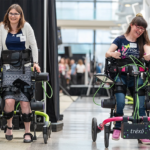Using ergonomics to help reduce pain from technology use
Study indicates interventions are needed to prevent musculoskeletal disorders from using smartphones.
Tim Schnettler, Texas A&M University School of Public Health December 16, 2021
The use of smartphones, tablets and laptops has become commonplace throughout the world and has been especially prevalent among college students. Recent studies have found that college students have higher levels of screen time, and they utilize multiple devices at higher rates compared to previous generations.
With the increased use of these devices, especially smartphones, students tend to use a less-traditional workplace such as a couch or chair with no desk, leading to an increase in musculoskeletal disorders in that age group.
A team of Texas A&M researchers led by Mark E. Benden PhD CPE, conducted a study looking at the technology students use, the postures they adapt when they use their device, and the amount of pain the students were currently experiencing.
Benden and his co-authors found that smartphones have become the most common link to educational materials though they have the least favorable control and display scenario from an ergonomic perspective. Additionally, the team concluded that regardless of device, ergonomic interventions focused on improving posture and facilitating stress management may reduce the likelihood of pain.
The results of the team’s study were published recently in the open-access, peer reviewed journal BMC Public Health.
“When we started this study a few years ago it was because we had determined that college students were the heavy users of smartphones,” Benden said. “Now those same levels we were concerned about in college students are seen in 40-year-olds and college students have increased to new levels.”
Benden, professor and head of the Department of Environmental and Occupational Health (EOH) at the Texas A&M University School of Public Health, and director of the Ergo Center, co-authored the study with EOH associate professors Adam Pickens PhD MPH, S. Camille Peres PhD, and Matthew Lee Smith PhD MPH CHES, Ranjana Mehta PhD, associate professor in the Wm Michael Barnes ’64 Department of Industrial & Systems Engineering, Brett Harp, a recent EOH graduate, and Samuel Towne Jr. PhD MPH CPH, adjunct assistant professor at the School of Public Health.
The research team used a 35-minute online survey that asked participants about their technology use, posture when using the technology, current level of pain or discomfort, and their activity and stress levels.
Among the respondents, 64 percent indicated that their smartphone was the electronic device they used most frequently, followed by laptops, tablets and desktop computers. On average, the students used their smartphone 4.4 hours per day, and they indicated that when doing so, they were more likely to do so on the couch or at a chair with no desk.
“It is amazing to consider how quickly smartphones have become the dominant tech device in our daily lives with little research into how that level of use would impact our health,” Benden said.
The researchers found that posture components and stress more consistently contributed to the pain reported by the students, not the variables associated with the devices they were using.
Still, the researchers point out that in our ever-increasing technology-focused society, efforts are needed to ensure that pain is deferred or delayed until an individual’s later years to preserve the productivity of the workforce.
“Now that we are moving toward hybrid and/or remote workspaces for our jobs, college students are taking habits formed in dorm and apartment rooms during college into young adulthood as employees in home offices,” Benden said. “We need to get this right or it could have adverse impacts on an entire generation.”
![]() Source Texas A&M University School of Public Health
Source Texas A&M University School of Public Health
| References |
Health-related consequences of the type and utilization rates of electronic devices by college students, Benden M, Mehta R, Pickens A, Harp B, Smith ML, Towne SD Jr, Peres SC. BMC Public Health. 2021 Nov 1;21(1):1970. doi: 10.1186/s12889-021-11975-3. Full text
| Further reading |
Posture during the use of electronic devices in people with chronic neck pain: A 3D motion analysis project, Lee R, James C, Edwards S, Snodgrass SJ. Work. 2021;68(2):491-505. doi: 10.3233/WOR-203245.
A systematic review of musculoskeletal complaints, symptoms, and pathologies related to mobile phone usage, Zirek E, Mustafaoglu R, Yasaci Z, Griffiths MD. Musculoskelet Sci Pract. 2020 Oct;49:102196. doi: 10.1016/j.msksp.2020.102196. Epub 2020 May 27.
Text neck and neck pain in 18-21-year-old young adults, Damasceno GM, Ferreira AS, Nogueira LAC, Reis FJJ, Andrade ICS, Meziat-Filho N. Eur Spine J. 2018 Jun;27(6):1249-1254. doi: 10.1007/s00586-017-5444-5. Epub 2018 Jan 6.
A comparison of upper body and limb postures across technology and handheld device use in college students, Szucs KA, Cicuto K, Rakow M. J Phys Ther Sci. 2018 Oct;30(10):1293-1300. doi: 10.1589/jpts.30.1293. Epub 2018 Oct 12. Full text
Prevalence and risk factors associated with musculoskeletal complaints among users of mobile handheld devices: A systematic review, Xie Y, Szeto G, Dai J. Appl Ergon. 2017 Mar;59(Pt A):132-142. doi: 10.1016/j.apergo.2016.08.020. Epub 2016 Sep 11.
Texting on mobile phones and musculoskeletal disorders in young adults: A five-year cohort study, Gustafsson E, Thomée S, Grimby-Ekman A, Hagberg M. Appl Ergon. 2017 Jan;58:208-214. doi: 10.1016/j.apergo.2016.06.012. Epub 2016 Jul 6.
Differential patterns of laptop use and associated musculoskeletal discomfort in male and female college students, Bubric K, Hedge A. Work. 2016 Nov 22;55(3):663-671. doi: 10.3233/WOR-162419.
Physical symptoms in young adults and their use of different computers and mobile phones, Korpinen L, Pääkkönen R. Int J Occup Saf Ergon. 2011;17(4):361-71. doi: 10.1080/10803548.2011.11076899.
Risk factors for generally reduced productivity–a prospective cohort study of young adults with neck or upper-extremity musculoskeletal symptoms, Boström M, Dellve L, Thomée S, Hagberg M. Scand J Work Environ Health. 2008 Apr;34(2):120-32. doi: 10.5271/sjweh.1218. Epub 2008 May 8.
Also see
Smartphone use could increase younger workers’ MSD risk Personnel Today
Internet of Bodies: Our Connected Future RAND Corporation
The Internet of Bodies Will Change Everything, for Better or Worse RAND Corporation







